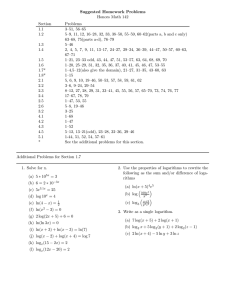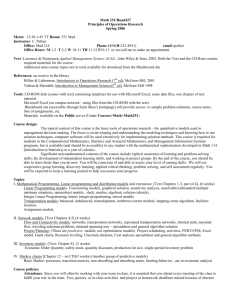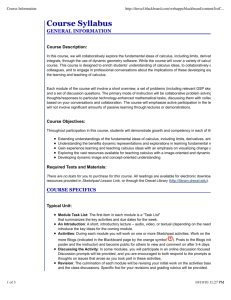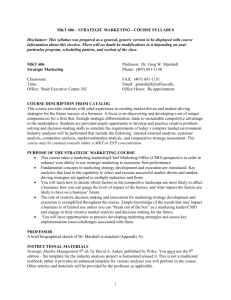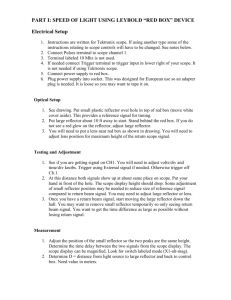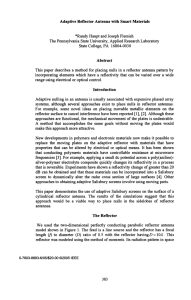Syllabus95 - Saint Mary`s College
advertisement
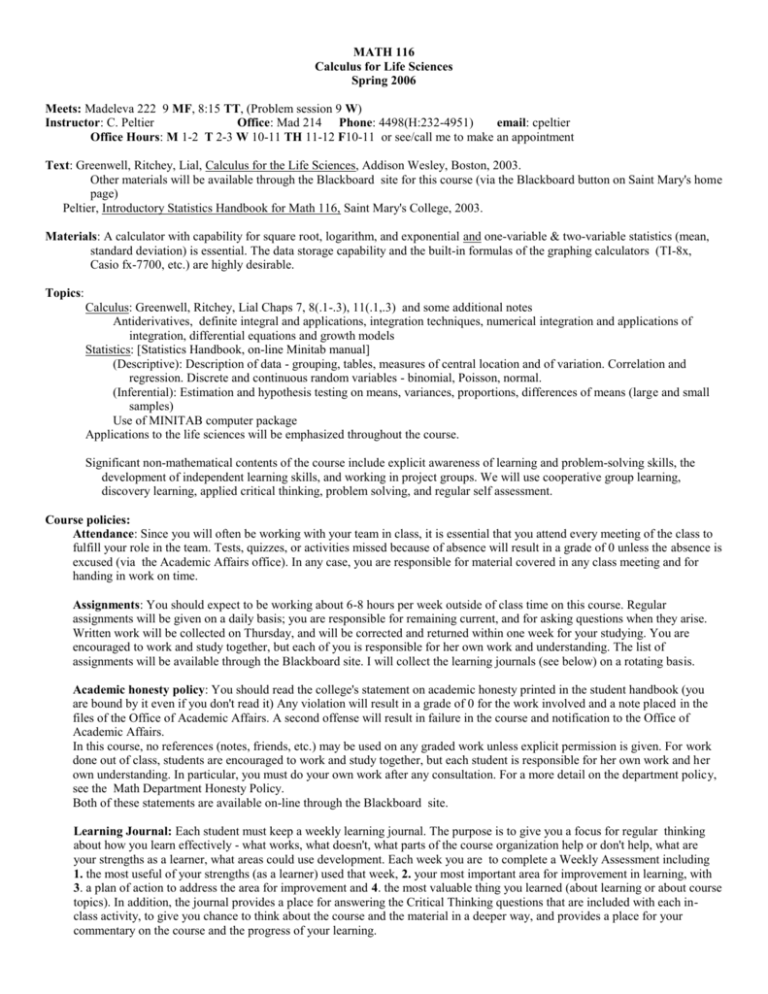
MATH 116 Calculus for Life Sciences Spring 2006 Meets: Madeleva 222 9 MF, 8:15 TT, (Problem session 9 W) Instructor: C. Peltier Office: Mad 214 Phone: 4498(H:232-4951) email: cpeltier Office Hours: M 1-2 T 2-3 W 10-11 TH 11-12 F10-11 or see/call me to make an appointment Text: Greenwell, Ritchey, Lial, Calculus for the Life Sciences, Addison Wesley, Boston, 2003. Other materials will be available through the Blackboard site for this course (via the Blackboard button on Saint Mary's home page) Peltier, Introductory Statistics Handbook for Math 116, Saint Mary's College, 2003. Materials: A calculator with capability for square root, logarithm, and exponential and one-variable & two-variable statistics (mean, standard deviation) is essential. The data storage capability and the built-in formulas of the graphing calculators (TI-8x, Casio fx-7700, etc.) are highly desirable. Topics: Calculus: Greenwell, Ritchey, Lial Chaps 7, 8(.1-.3), 11(.1,.3) and some additional notes Antiderivatives, definite integral and applications, integration techniques, numerical integration and applications of integration, differential equations and growth models Statistics: [Statistics Handbook, on-line Minitab manual] (Descriptive): Description of data - grouping, tables, measures of central location and of variation. Correlation and regression. Discrete and continuous random variables - binomial, Poisson, normal. (Inferential): Estimation and hypothesis testing on means, variances, proportions, differences of means (large and small samples) Use of MINITAB computer package Applications to the life sciences will be emphasized throughout the course. Significant non-mathematical contents of the course include explicit awareness of learning and problem-solving skills, the development of independent learning skills, and working in project groups. We will use cooperative group learning, discovery learning, applied critical thinking, problem solving, and regular self assessment. Course policies: Attendance: Since you will often be working with your team in class, it is essential that you attend every meeting of the class to fulfill your role in the team. Tests, quizzes, or activities missed because of absence will result in a grade of 0 unless the absence is excused (via the Academic Affairs office). In any case, you are responsible for material covered in any class meeting and for handing in work on time. Assignments: You should expect to be working about 6-8 hours per week outside of class time on this course. Regular assignments will be given on a daily basis; you are responsible for remaining current, and for asking questions when they arise. Written work will be collected on Thursday, and will be corrected and returned within one week for your studying. You are encouraged to work and study together, but each of you is responsible for her own work and understanding. The list of assignments will be available through the Blackboard site. I will collect the learning journals (see below) on a rotating basis. Academic honesty policy: You should read the college's statement on academic honesty printed in the student handbook (you are bound by it even if you don't read it) Any violation will result in a grade of 0 for the work involved and a note placed in the files of the Office of Academic Affairs. A second offense will result in failure in the course and notification to the Office of Academic Affairs. In this course, no references (notes, friends, etc.) may be used on any graded work unless explicit permission is given. For work done out of class, students are encouraged to work and study together, but each student is responsible for her own work and her own understanding. In particular, you must do your own work after any consultation. For a more detail on the department policy, see the Math Department Honesty Policy. Both of these statements are available on-line through the Blackboard site. Learning Journal: Each student must keep a weekly learning journal. The purpose is to give you a focus for regular thinking about how you learn effectively - what works, what doesn't, what parts of the course organization help or don't help, what are your strengths as a learner, what areas could use development. Each week you are to complete a Weekly Assessment including 1. the most useful of your strengths (as a learner) used that week, 2. your most important area for improvement in learning, with 3. a plan of action to address the area for improvement and 4. the most valuable thing you learned (about learning or about course topics). In addition, the journal provides a place for answering the Critical Thinking questions that are included with each inclass activity, to give you chance to think about the course and the material in a deeper way, and provides a place for your commentary on the course and the progress of your learning. Leave space for instructor feedback with each week's entry. Feel free to add other related materials, comments and reflections to your learning journal. If you wish, you may use the outline page in the Course Documents area of the Blackboard site. I will collect the reflector's learning journal the first class following the week in which she is the reflector. Team Participation: There is a focus on working in teams in this course. A good portion of your working time will be spent working with your team. You are expected to attend all sessions scheduled by your team. In-class learning activities: There will be a number of in-class learning activities (about one a week) to be carried out in your learning teams. There are several specific roles [see the document “Team Roles and Performance Criteria”] to be filled in performing this activity, and the team will present a report and written work at the end of the activity. Each activity will also include several critical thinking questions [going beyond the specific task of the activity] to be answered by each team member in her learning journal. At the end of the activity, the team will hand in a report containing (at least) 1. table of contents 2. recorders report (including any written work products) 3. reflector's report * [see below] 4. Team's grade (0.0-5.0) for their teamwork on the activity [based on success with the activity and success in working as a team]. I will also assign a grade (0-5 pts) - if the grade you assign is indefensibly high, there will be a penalty. *The reflector's report must include: 1. Role, strength and area for improvement of each participating team member; 2. Greatest strength of the team as a whole [used in this work], two areas most in need of improvement[as shown in this work], Grading: Four in-class tests In-class activities (team) Learning journal (individual) Homework Data analysis project (individual) Cumulative final examination 45-55% 15-25% 5-10% 5-10% 5% 10-20% You will (individually) select percentages in the given ranges so the grading may better reflect your own learning style and preferences. A deadline will be set (about the third week of the semester) for your choice. The grading scale is based on: 60% < D < 70% < C < 80% < B < 90% < A, with + and - grades occupying the top and bottom 2% of the ranges (No A+ or D- grades). Test dates: 2/9, 3/2, 4/6, 4/27 Final exam Thurs 5/11 8am Topic outline Week Text sections 1 1.1-7.2 2 7.2, 7.3 3 7.4-7.6 4 7.6, 8.1 5 8.1-8.3 6 8.3,11.1 (handout) 7 11.3, ch 0 8 Ch 0-1 9 Ch2 10 Ch 3 11 Ch 4 12 ch 5, ch 6 13 ch 7 14 ch 8 15 ch9,10 samples) topics Review of topics from first semester Substitution, the Definite integral Findamental theorem of Calculus, calculation, trig functions, area Area between curves, T1(7.1- 7.6) Numerical integration Numerical integration, Integration by parts, Applications Applications, Differential equations, growth models Euler’s approximation method, T2 (8.1-3, 11.1,3) Begin Statistics Basic ideas of statistics, descriptive statistics (1&2 variable) Basic probability Discrete random variables - binomial, Poisson families Continuous random variables, the normal distribution T3 (ch0-4) Distribution of sample means, estimation (t-dist) Hypothesis tests on a population mean Inference on a proportion, T4(ch5-8) Inference on difference of means (paired data, independent


